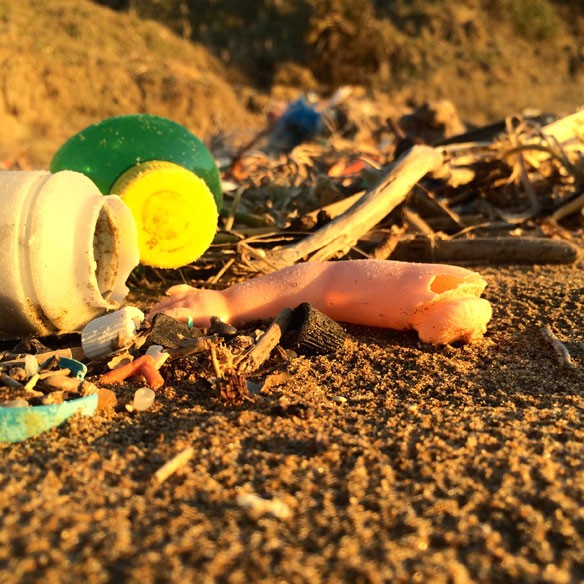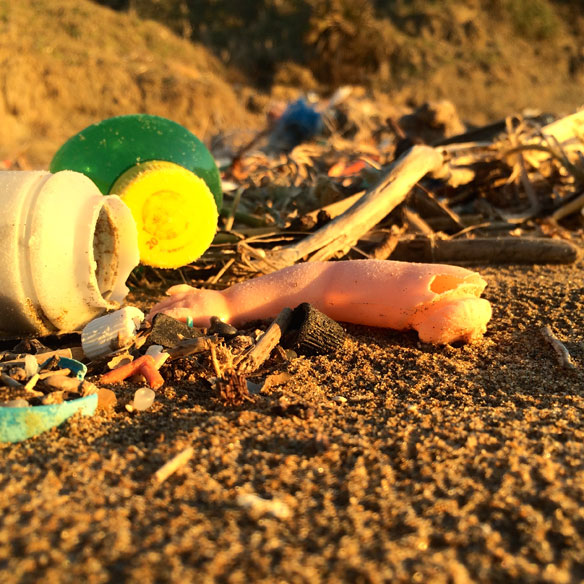
“The unprecedented plastic waste tide plaguing our oceans and shores, can become as limited as our chosen relationship with plastics, which involves a dramatic behavioral change on our part…”
Captions and Photo: © SAF — Coastal Care
Excerpts;
Biodegradable plastic water bottles and shopping bags are a false solution to the ubiquitous problem of litter in the oceans, the UN’s top environmental scientist has warned, speaking at the the UN environment assembly in Nairobi, where 170 countries are meeting and expected to pass a resolution on microplastics later this week…
Read Full Article, Guardian UK
Original Report: “MARINE PLASTIC DEBRIS AND MICROPLASTICS: Global lessons and research to inspire action and guide policy change,” UNEP-05-2016
Marine Plastic Debris and Microplastics: Global Lessons and Research to Inspire Action and Guide Policy Change found that in 2014, global plastic production exceeded 311 million metric tonnes, a 4 per cent increase over 2013. Between 4.8 and 12.7 million tonnes ended up in the ocean as a result of inadequate solid waste management. Microplastics are of particular concern.
One study estimated that, on average, every square kilometre of the world’s oceans has 63,320 microplastic particles floating at the surface. Marine organisms – including zooplankton, invertebrates, fishes, seabirds and whales – can be exposed to microplastics through direct ingestion of water and indirectly as predators in food webs. Potential adverse effects of microplastic ingestion include immunotoxicological responses, reproductive disruption, anomalous embryonic development, endocrine disruption, and altered gene expression.
Gender and Plastic Management looked at the differing roles of men and women in plastic use and consumption, identifying women in wealthy regions as important stakeholders in reducing plastics in basic consumer goods.
Plastic and Microplastics in our Oceans – A Serious Environmental Threat; UNEP
Marine litter causes economic adversity for coastal communities and negatively affects the health of both marine life and human beings. It’s a global problem that requires global solutions…
Biodegradable Plastics Are Not the Answer to Reducing Marine Litter, Says UN; UN News Center (11-23-2015)
Widespread adoption of products labelled ‘biodegradable’ will not significantly decrease the volume of plastic entering the ocean or the physical and chemical risks that plastics pose to marine environment, concluded a UN report released today…
Biodegradable Plastics Are as Persistent as Regular Plastics, Study Finds, Yale E360 (03-19-2015)
Plastics designed to degrade don’t break down any faster than their conventional counterparts, according to research published in the journal Environmental Science and Technology…
Here’s How Much Plastic Ends Up In the World’s Oceans,The Time (02-13-2015)
Every year, 8 million metric tons of plastic end up in our oceans, it’s equivalent to five grocery bags filled with plastic for every foot of coastline…
Plastic Contaminates Ocean Sourced Table Salt, Scientific American (10-30-2015)
When researchers analyzed fifteen brands of common table salt bought at supermarkets across China, they found among the grains of seasoning micro-sized particles of plastic. The highest level of plastic contamination was found in salt sourced from the ocean…
An ocean of plastic: Magnitude of plastic waste going into the ocean calculated, UCSB Current
Plastic pollution: When The Mermaids Cry: The Great Plastic Tide, Coastal Care
For more than 50 years, global production and consumption of plastics have continued to rise. An estimated 299 million tons of plastics were produced in 2013, representing a 4 percent increase over 2012, and confirming and upward trend over the past years. In 2008, our global plastic consumption worldwide has been estimated at 260 million tons, and, according to a 2012 report by Global Industry Analysts, plastic consumption is to reach 297.5 million tons by the end of 2015.
Plastic is versatile, lightweight, flexible, moisture resistant, strong, and relatively inexpensive. Those are the attractive qualities that lead us, around the world, to such a voracious appetite and over-consumption of plastic goods. However, durable and very slow to degrade, plastic materials that are used in the production of so many products all, ultimately, become waste with staying power. Our tremendous attraction to plastic, coupled with an undeniable behavioral propensity of increasingly over-consuming, discarding, littering and thus polluting, has become a combination of lethal nature… — © SAF — Coastal Care
People may be breathing in microplastics, health expert warns, Guardian UK (05-10-2016)
People could be breathing in microparticles of plastic, according to a leading environmental health expert, with as yet unknown consequences on health…









